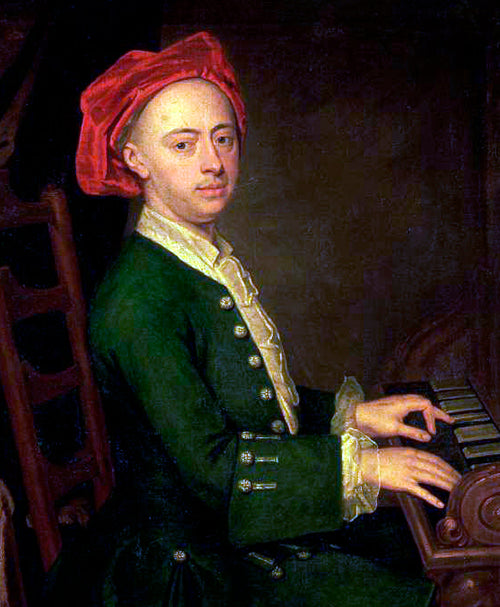In ancient Greek mythology, Semele is a mortal woman favored by the god Zeus. She becomes pregnant with his child. When Zeus’ wife, Hera, finds out, she disguises herself as an old hag and convinces Semele to demand an amazing gift from her lover. Semele insists that Zeus show himself to her in all his immortal glory, an experience that Zeus knows no mortal can withstand. But he’s bound by his promise, and the overwhelmed Semele dies. From her body Zeus rescues the unborn demi-god Dionysus.
There was something about this story that intrigued composers and librettists during the Baroque period. Most famously, George Frideric Handel set it as a sort of hybrid of opera and oratorio. The work, using a pre-existing libretto by William Congreve, was premiered in 1744.
But Handel was not alone in his attraction to this fantasy filled with passion, violence, and deceit. Nor was he the first to adapt it. In around 1707, John Eccles set that same Congreve libretto. Then the Parisian composer Marin Marais (1656 – 1728) wrote an opera based on the Semele story in 1709, and ten years later another Frenchman named André Destouches (1672 – 1749) used it as material for a chamber cantata. All four are represented on some (relatively) recent recordings.
It’s always interesting to compare how different creative teams handle the same source material. As its title suggest, Sémélé: Haendel, Marais & Destouches on Mirare Records does just that. This is a project by the French ensemble Les Ombres, for which Margaux Blanchard and Sylvain Sartre shared the role of artistic director.
Les Ombres’s recording is based on a concert program they developed in 2013. The 30 tracks include the overture and some arias from each version, plus some other Handel works as fillers, including his complete Concerto Grosso No. 4. It’s hard to know why they felt they needed this extraneous Handel rather than including more excerpts from the three Semele operas; perhaps it made more sense in the live show.
Marais’s version of Semele uses a libretto by French novelist Antoine Houdar de la Motte. It is labeled as a Tragédie en musique, the kind of melodramatic sung tragedy with dancing that was an obsession for King Louis XIV, who was still France’s monarch at the time. A hallmark of any French lyric tragedy was its stately ouverture. Les Ombres directors Blanchard and Sartre avoid too much emphasis on “over-dotting” – lengthening the first part of every beat, considered a standard conceit of the early Baroque performance practice – instead making the dotted rhythms more relaxed. As a result, they capture the fluidity of Marais’s masterful ensemble writing.
As far as I could find, the Destouches Semele has never been recorded as a complete opera. Only a few movements of it are included here. One interesting thing about Destouches’s version is that he chose not to have Semele die in screaming terror when Zeus reveals his godly grandeur, but instead allows her to be overcome in a fit of ecstasy. The mellifluous contralto voice of Mélodie Ruvio is an ideal match for the courageous Semele. Here she sings “Est-il un destin plus heureux” (Is there a happier fate):
A similar comparative project was recently undertaken on the Harmonia Mundi label, but with less specific focus on Semele. On its album Portraits de la Folie, Ensemble Amarillis includes two arias from the Destouches version and one from the Marais, along with a wide range of other 17th-century vocal music expressing the madness of love. The soloist is mezzo-soprano Stéphanie D’Oustrac, whose nimble yet powerful voice has utterly mastered early-Baroque ornaments for emotional effect. The performance is directed by Héloïse Gaillard. There are no free-streaming excerpts available, but you can hear the whole album on Qobuz. (Recommended track: Destouches’s aria “Ne cesse pointe le m’enflamme”):
You have to go back to 2007 for a complete recording of the Marais Semele, when Le Concert Spirituel, led by Hervé Niquet, released it on Glossa Music. Not so incidentally, the same group also made a recording of Destouches’s forgotten opera Callirhoé.
Marais had a gift for creating orchestral richness. He was himself one of the greatest viola da gamba players of his time, so among his compositional secret weapons was the way he used the middle and lower instrumental voices to develop his sound. (I’ll be writing more about this exceptional composer soon, so keep an eye on this column.) Niquet’s recording wonderfully captures that luxurious texture.
Yet Marais wrote equally well for brass and winds, and the interplay between those sections and the strings is on display in the aria “Gouton icy les plus doux charmes” (Taste here the sweetest charms) sung by Jaël Azzaretti as the High Priestess of Dionysus. You will find it at the 13:10 mark on this complete recording:
About two years older than Marais’s Semele is the one by British composer John Eccles. It can now be heard in its entirety thanks to the Academy of Ancient Music, conducted by Julian Perkins, on the AAM’s own label. To mark the first recording of the work, this two-CD set comes with a booklet packed with interesting essays, including one about how English opera might have grown up post-Purcell if Handel hadn’t brought all his Italian ideas into the mix when he relocated to London.
Eccles worked with librettist William Congreve to adapt the Semele story as it appears in Ovid’s Metamorphoses. The language is poetic yet not highly ornamented. The same might be said for the music. One thing to note is the simplicity of form, a spare ABA form without the length and complexity that would later be found in Handel’s “dal segno” arias. The numbers themselves are therefore very short. Here is tenor Williams Wallace, singing as Athamas, a prince of Boeotia.
The music has clarity and charm, and comparisons to Henry Purcell are impossible to avoid. The performance by the Academy of Ancient Music sculpts every phrase with an exquisite gallantry. Listen to the delicate introduction and ritornello of “Turn, Hopeless Lover, Turn Thy Eyes,” an aria for Semele’s sister Ino, sung by Aoife Miskelly.
Eccles’ Semele is a gem, and fans of the early Baroque are lucky to have this beautiful recording of it. But we must not ignore the elephant in the room. Handel did, after all, move to London, and his effect on opera and oratorio was enormous.
For his Semele, Handel used the same Congreve libretto written for Eccles. The fact that it’s in English and features complex choral writing are both traits typical of Handel’s oratorios. But Semele also deals with a decidedly non-Christian topic and tells a story through sung dialogue rather than narration and commentary, making it like an opera. The composer simply labeled it as a “musical drama.”
Because it’s Handel, there are numerous recordings out there. The newest is from 2022, a release on Ricercar by the Choeur de Chambre de Namur and the Millennium Orchestra, with Leonardo García-Alarcón conducting. Bass-baritone Andreas Wolf sings Cadmus, King of Thebes, and soprano Ana Maria Labin is the title character. Although Labin’s voice gets a bit overcome with vibrato on longer notes, she is fearless on the brutal, high-speed melismas Handel saddles her character with, for example in “No, I’ll Take Less.” And the orchestra genuinely sparkles.
For all his contributions to the development of music at the end of the Baroque, Handel’s writing for chorus is arguably his greatest accomplishment. It’s interesting to hear him use his estimable polyphonic skills on a text that would never show up in one of the Old Testament stories he relied on for his oratorios. In “Endless Pleasure, Endless Love,” the Namur choir lacks the passion required for the words, but Handel’s writing is exemplary.



